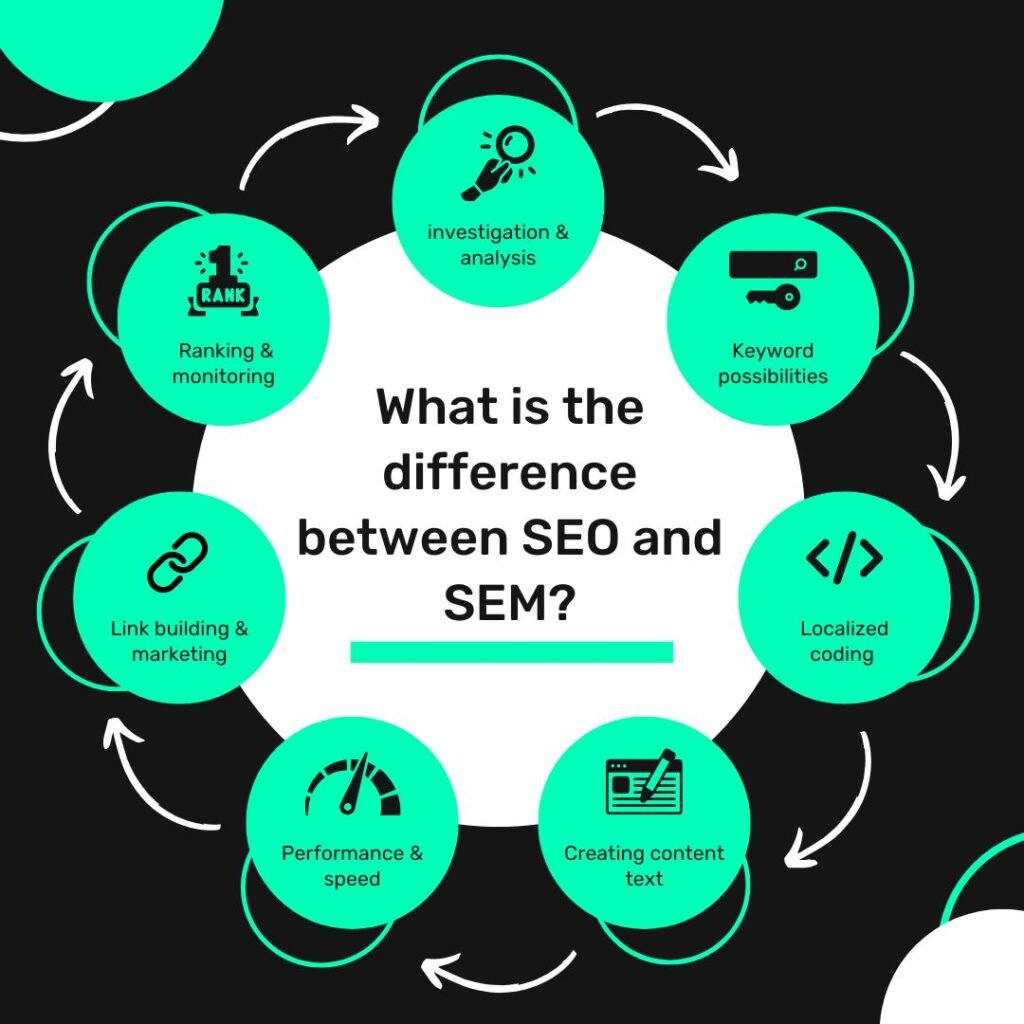If you’ve ever tried to grow your website traffic, chances are you’ve come across the terms SEO and SEM. At first glance, they might seem interchangeable. After all, both aim to drive more visitors to your website. But in reality, SEO and SEM are two distinct digital marketing strategies — each with its own tactics, benefits, and purposes.
So, what is the difference between SEO and SEM? Let’s dive deep, demystify the jargon, and help you understand how each works and when to use them.
Understanding the Basics: SEO vs. SEM
What is SEO?
SEO stands for Search Engine Optimization. It refers to the process of improving your website to increase its visibility when people search for products or services related to your business on search engines like Google or Bing.
Think of SEO as the organic way to earn traffic. You don’t pay for placement; instead, you optimize your content and website to earn your spot on the search engine results pages (SERPs).
Key Components of SEO
- On-Page SEO: Optimizing content, title tags, meta descriptions, images, and internal links.
- Technical SEO: Enhancing site speed, mobile-friendliness, indexing, and crawlability.
- Off-Page SEO: Building backlinks from other reputable websites.
What is SEM?
SEM stands for Search Engine Marketing. It’s a broader term that encompasses all strategies used to gain visibility in search engines, including paid advertising.
While SEO is a component of SEM, the term SEM is more commonly used to refer specifically to paid search advertising, like Google Ads (formerly AdWords).
Key Components of SEM
- Paid Search Ads: Appear at the top of the SERPs, often labeled as “Ad.”
- PPC (Pay-Per-Click): You pay each time someone clicks your ad.
- Keyword Targeting: Bidding on specific keywords to show ads to relevant searchers.
SEO vs. SEM: Main Differences
Let’s break down the core differences between these two strategies:
| Feature | SEO | SEM |
|---|---|---|
| Cost | Generally free (but requires time and effort) | Paid (per click or impression) |
| Speed | Takes time to see results | Immediate visibility |
| Longevity | Long-term traffic | Traffic stops when ads stop |
| Positioning | Organic results | Paid listings (above organic) |
| ROI | High in the long run | Quick returns, higher short-term costs |
A Real-Life Analogy
Imagine opening a new coffee shop.
- SEO is like getting great Yelp reviews, optimizing your Google My Business profile, and creating Instagram-worthy posts. It takes time but builds a strong reputation.
- SEM is like putting up billboards and running radio ads. You get immediate attention, but you pay for every second of visibility.
Both are powerful, but they work differently.
The Pros and Cons of SEO
Pros
- Cost-effective: You don’t pay per click.
- Builds credibility: Users trust organic results more.
- Long-term value: Content can rank for years.
- High ROI: Especially for evergreen content.
Cons
- Time-consuming: It can take months to see results.
- Competitive: Top spots are hard to earn.
- Algorithm changes: SEO is constantly evolving.
The Pros and Cons of SEM
Pros
- Immediate results: Start seeing traffic right away.
- Precise targeting: Control who sees your ads.
- Great for testing: Quickly test offers and landing pages.
Cons
- Cost: Can get expensive, especially for competitive keywords.
- Short-term: Once you stop paying, the traffic stops.
- Ad blindness: Some users skip over ads.
When to Use SEO vs. SEM
Use SEO When:
- You have a limited budget.
- You’re focused on long-term growth.
- You want to build brand authority.
- You have time to invest in content and optimization.
Use SEM When:
- You need quick traffic and conversions.
- You’re launching a new product or service.
- You’re testing a new market.
- You want to target specific geographic locations or demographics.
Expert Insight:
“Use SEM to gather data and drive quick wins, then use that data to inform your long-term SEO strategy.” — Neil Patel, Digital Marketing Expert
How SEO and SEM Work Together
Contrary to popular belief, SEO and SEM are not rivals — they’re teammates.
By combining both, you can:
- Own more real estate on the SERPs.
- Use SEM data to find high-performing keywords for SEO.
- Run A/B tests on paid landing pages before committing to SEO content.
Real-World Example
E-commerce giant Zappos uses SEM to promote seasonal sales and new product lines, while their blog and product pages are heavily optimized for SEO. This hybrid strategy keeps them visible year-round.
SEO and SEM in Numbers
Here are some data-driven insights to help contextualize their importance:
- SEO drives 53% of all trackable website traffic (BrightEdge).
- Google Ads users earn $2 for every $1 spent on average (Google Economic Impact Report).
- 75% of users never scroll past the first page of Google (HubSpot).
- Organic results are clicked 10x more than paid ads on average (Sparktoro).
Choosing the Right Strategy for Your Business
No one-size-fits-all answer exists. Your choice depends on:
- Budget: Can you afford ad spend?
- Timeline: Do you need traffic now or later?
- Resources: Do you have the time or team for SEO?
- Goals: Are you building a brand or running a time-sensitive campaign?
A Balanced Approach
The smartest businesses don’t choose one over the other. They use SEO and SEM together, strategically, depending on the stage of the funnel or campaign lifecycle.
Final Thoughts
Understanding the difference between SEO and SEM is crucial for any digital marketing strategy. SEO helps you build long-term, sustainable traffic. SEM gives you instant visibility and fast results.
Used wisely, these tools can complement each other, giving you both immediate impact and lasting growth.
So instead of asking which one is better, ask: How can I use both to my advantage?
If you’re ready to take your traffic to the next level, don’t choose between SEO and SEM — master them both.
Frequently Asked Questions (FAQs)
What is the main difference between SEO and SEM?
SEO focuses on organic search traffic, while SEM includes paid search advertising.
Can I do SEO and SEM at the same time?
Absolutely! Many businesses use both for maximum visibility and performance.
Which is better for a small business?
SEO is often more sustainable long-term, but SEM can help small businesses get noticed quickly.
Is Google Ads part of SEM?
Yes. Google Ads is one of the most common SEM platforms.
How long does SEO take to show results?
Typically, 3 to 6 months for noticeable results, depending on the industry and competition.
Does SEM help SEO?
Not directly, but it can provide valuable keyword data and audience insights to inform SEO efforts.


